Ron Ludekens
Cooke's Purple Wisteria History

COOKE'S PURPLE™ WISTERIA
Wisteria sinensis 'Cooke's Purple'
Cooke's Purple™ Wisteria is the result of my interest in having a purple blooming selection.
In 1963, Dr. James Miller of Exeter, my optometrist, wanted me to see a seedling wisteria he liked. Most seedlings do not bloom and home owners become upset with wisteria without bloom. I was not interested in seeing another wisteria as we had 28 but I was volunteering with Dr. Miller in Boy Scouts, so went as a courtesy.
This Exeter wisteria was a showy vine growing up a utility pole and the guy wire. I liked it but was not as dark as I was seeking. I had some grafted and planted in our scion wood orchard in 1966. When we built our home the following year at the back of the orchard, we placed our driveway along the 500 feet of wisteria. We soon observed it had a very heavy bloom in the spring prior to leafing, but it also had smaller flower spikes all summer. We have visitors and photographers coming up our driveway during the spring to see the wisteria on the south side and the redbuds on the north.
We now have two rows of Cooke's Purple™ Wisteria along our home driveway with solid 18 inch flowers during late March into early April, and also have small 8"-12" flower racemes from April 15 to September 15. July and August there is a heavier flower set. The summer flowers start more as a spur out of the vine but weeps as it elongates. Where a few other wisterias such as Texas White the L. E. Cooke Co introduced had 3 short summer flowering periods, the Cooke's Purple has color for five months during the summer in addition to the heavy spring bloom before foliage. First listed in our catalog 1971-72.

Summer Re-Bloom
Because of its fantastic spring bloom and (at the time unique) summer re-bloom, Cooke's Purple™ Wisteria has become the major seller not only in the southwest where first introduced but now nationwide. Many nurseries tell me about their success with Cooke's Purple as it blooms the first season before the first leaves. We often have flowers from the newly budded or grafted vines in our fields. Some other flowering wisteria varieties require 4 to 5 years before blooming.
Robert Ludekens 2-20-2014
Cooke's Purple™ Wisteria Information Page - Point of Sale Page
Caroline Wisteria History

CAROLINE PURPLE WISTERIA
Wisteria sinensis 'Caroline'
This selection was found in Santa Monica, California by William H. Chandler and named after his wife. Mr. Chandler was the Dean of Agriculture at UCLA. This wisteria was introduced through the arboretum at UCLA by Ms. Mildred Mathis. She planted it in the campus gardens. Ms. Mathias was a member of the World Identification Board became aware of Bob Ludekens' search for a purple wisteria. Mr. Ludekens is a graduate of UCLA. The L. E. Cooke Co. received graft wood from the arboretum about 1962 and included in our 1969-70 catalog after a review for several years of the bloom.
Today Caroline Purple Wisteria is still one of the best showy flowers in the spring and will bloom the first year for the nurseries. It grows well in the mild winter areas as well as in our warm central valley. We would consider it one of the nicest spring wisteria flowers for it is early, has good foliage, and a slightly larger flower than most. Caroline is very dependable for blooming.
A book published by Peter Valder lists in his chapter as a floribunda. The L. E. Cooke Co. lists as a sinensis as the plant blooms the first year and has flowers similar to other sinensis and the seedlings look like sinensis. Where most floribunda takes years to flower, Caroline will flower the first year from grafts.
Bob Ludekens 2-20-2014
John Fanick Peach History

JOHN FANICKTM PEACH
Mr. Eddie Fanick introduced many shade and ornamental trees and a few fruit varieties. His son John managed their large retail nursery with many acres of trees being tested in their research orchard. A fruit tree from a seedling of La Feliciana near the nursery front door had high quality fruit.
John's sons wanted to introduce the tree to their San Antonio customers and named it after their father John Fanick. The original bud wood was supplied in August 2000. The L. E. Cooke Co. has grown this selection for their Fanick Garden Center where they sell well over 100 each year. This named variety surely enhances the Fanick's name.
John FanickTM Peach is large, freestone, yellow flesh fruit with excellent flavor. The skin has an 80% red blush. The tree's spring bloom is attractive and adds a dual season as a flowering tree. The tree produces abundant crops with ripening mid to late July. An L. E. Cooke Co. introduction to the trade.

Attractive Spring Bloom
Robert Ludekens 12-27-2013
Fan-Cris Pear History

FAN-CRISTM PEAR
Mr. Eddie Fanick gave the L. E. Cooke Co the Fan-StilTM pear which we liked. Later he provided Fan-CrisTM which we planted in our orchard in 1981. We had too many pears, so decided not to put into production. The 1981 tree is still in Cooke I research orchard. We did not treat the tree for pear blight and it sets a heavy crop of good pears every year. The sales staff determined the pear was too good not to add to our selections and we added it in 2008. We should have made this decision years earlier.
The fruit is medium to large bell shape. The flesh has a solid, creamy texture that crunches when you bite into it. The pear is excellent for dessert use. The tree has resistance to fire blight, sets a large crop and ripens from August into September. The fruit holds well on the tree. The Fan-CrisTM is a good backyard tree when able to pick 10 or more each day for weeks.
Bob Ludekens 1-14-2014
Fan-Cris™Pear Information Page - Point of Sale Page
Additional Fan-Cris™ Pear Photos
Fan-Stil Pear History

FAN-STILTM PEAR
Mr. Eddie Fanick supplied budwood in about 1967. The L. E. Cooke Co put it into production in 1972. This selection has been a very steady seller because of its resistance to pear blight and the high production of quality fruit. It is a pleasurable pear to grow as it continued to increase in production for years and when sales leveled off, it never went down as others have.
Retail nurseries change fruit varieties like ladies change fashions. Many varieties grow in sales and then peak and sales decline as nurseries try a new selection. Fan-StilTM sales peaked and held steady so production continues.
The fruit is medium bell shape, canary yellow skin with slight red blush, crisp juicy white flesh. The tree has vigorous very upright growth; bears consistently, fruit ripens late August into September. The selection has never shown any fire blight in our orchards or fields but there has been one or two reports of some in the east.
Bob Ludekens 1-13-2014
Fan-Stil™ Pear Information Page - Point of Sale Page
Fan-West Ash History
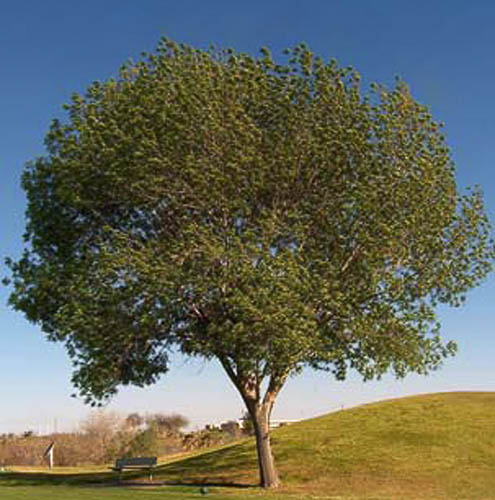
FAN-WESTTM ASH
(Fraxinus 'Fan-West')
(Photo courtesy City of Tempe)
In the mid 1960's Mr. Eddie Fanick introduced Fan-WestTM and Fan-Tex AshTM. Fan-WestTM is a natural hybrid of Texas Green Ash (Fraxinus pennsylvanica) and Arizona Ash (Fraxinus velutina). The L. E. Cooke Co planted Fan-WestTM in our orchard in 1966 and it still looks good today.
We had many Green Ash and hardy Ash for Canada and northern states. We began with Fan-TexTM in 1968 and it became popular in Texas, New Mexico, Arizona, and some in Southern California.
November 8, 1973, Mr. Fanick informed us the Fan-WestTM buds out late and he found it to be hardy - good for cold weather areas. The variety is sterile (seedless) and defoliates early in the fall similar to other Green Ash. It is a very sturdy tree.
We listed Fan-WestTM in 1974. Like other Green Ash at the time, it was not a major seller for us. Part of the problem we had too many hardy Ash. We discontinued sales in 1998.
We relisted it in 2005 by request as customers in Arizona, Nevada and New Mexico were becoming impressed with the tree's performance. The vigorous, sterile ash is super tough. It thrives in poor, dry soils and also grows well in cold, windy, harsh locations. This outstanding deciduous shade tree has a strong upright central leader and broad, rounded crown with great branching.
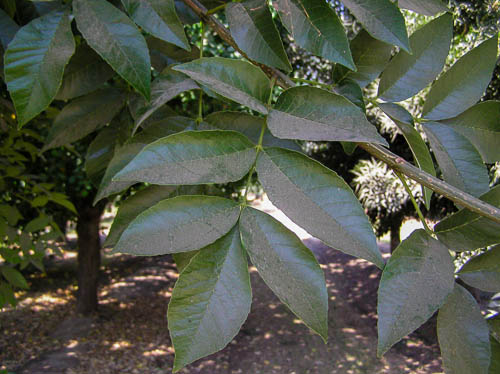
The question is - how hardy? It is good in northern Texas and grows in New Mexico which can drop to below zero for short periods. I do not see where we have sold Fan-West in the northern states like we do the Marshall Seedless Ash or some of the other hardy selections. The tree has the growth habits of other Green Ash, but I do not believe we have properly tested Fan-WestTM. Unfortunately in early 1970's, we had two Green Ash, 2 Blue Ash, holotricha (Moraine Ash), and two American Ash which were all hardy in very cold climates, so we never tested Fan-West in more extreme cold.
Questions: Will it live and grow in Reno, Nevada? I wrote the grandson Mike Fanick. He does not believe so. He said in the 1980's they saw damage on trees with temperatures with 0° to10° F. He felt a constant temperature below 0° would kill this variety. This is not surprising as it has Arizona Ash in the parentage with Green Ash .
Bob Ludekens 2-25-2014
Arctic Fantasy Nectarine History

HISTORY OF ARCTIC FANTASY® NECTARINE
L. E. Cooke Co. Introduction
Summer of 1991 E. Ray Houston, a retired teacher from Cal Poly (SLO), sent the L. E. Cooke Co budwood from a white seedling nectarine he had found. We budded and planted a few in January 1993 in the Cooke I research area where they still are of this writing in January 2014.
All sales staff, management, and office personnel sampled the fruit and compared it with other white selections in 1996. A list of 45 possible names were submitted by many and then voted as to the best. Arctic Fantasy® was selected and the L. E. Cooke Co trademarked the name.
Ray received some of the original trees budded in 1993. Unfortunately he passed away prior to being able to see it listed for the first time as Arctic Fantasy® in our 2001-02 catalog.
Most of us prefer Arctic Fantasy® over the longtime favorite Goldmine. The fruit is larger, has a stronger flavor, and better skin color. It has a sweet white flesh, sub-acid and a flavor similar to some of the yellow varieties. The red overlays 70% to 80% of the skin making an attractive fruit. The nectarine is freestone, ripens in early August. A very good white selection planted in any 400 to 800 chill hour areas. Arctic Fantasy grows well in San Luis Obispo.
Bob Ludekens January 2014
Austin Pomegranate History

AUSTIN POMEGRANATE HISTORY
The Austin Pomegranate came from central Texas. Richard Ashton, owner of Oak Creek Orchards in Brownwood, Texas contacted us about this fruit. Richard is a collector of pomegranates and wrote a book on pomegranates. This pomegranate came from Austin (hence the name) by way of a Syrian immigrant who brought this pomegranate from Syria.
Ron Ludekens arranged for cuttings in 2007. We had limited production starting in 2009 with efforts to increase volume to match sales demand in 2014 and beyond.
The fruit is large with pink skin and red blush, red to dark red extremely large arils contrasting to the skin color. The arils are very easy to remove, normally falling out when cutting the fruit. The juice content is high, 1.5 times that of Wonderful. The juice is sweet with just a bare hint of tartness, and superior taste compared to most sweet varieties. The plant is a vigorous grower and the fruit resists cracking. A large established plant will produce about 200 pounds of fruit, many times others. The fruit ripens in October, and has some cold hardiness.
Bob Ludekens
Different Ripening Times
Question: I would like to grow three different semi-dwarf peach trees that ripen at different stages. Can you please suggest a few? Pete - Atascadero, CA
Answer: I love it when a homeowner plans for fruit all summer! And this is an ideal use of our recommended variety lists as well. These lists give you choices and some of those choices like Peaches are spread over ripening months.
Step 1) What is your Sunset Zone? Look it up by your zip code here: Sunset Climate Zone by Zip Code or by US Map
Step 2) Look at or print the Recommended Variety List for that Sunset Zone from this page: Recommended Variety Lists
Step 3) Chose your favorite varieties and call your local nursery for availability (or pre-order from them for next January- March delivery).
Pete, in your case, Atascadero is in Sunset Zone 7. Here is our recommended variety list for Sunset Climate Zone 7.
Hope this tool is useful for everyone.
Ron Ludekens 7-13-13
Flame Mimosa - Fan Silk Albizia
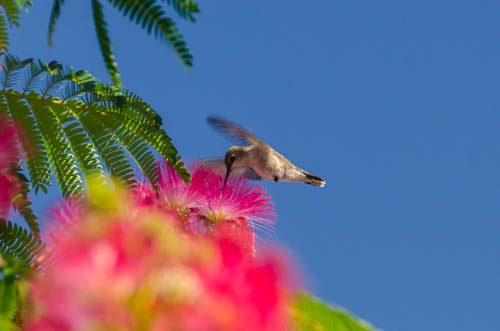
Humming Bird hovering over flower of Flame Mimosa (Fan Silk Albizia)
Last week I walked a part of the Budwood Orchard to check out some new trees in our evaluation block. A few rows over, the bright red blooms of the Fan Silk Albizia (Flame Mimosa) caught my eye.
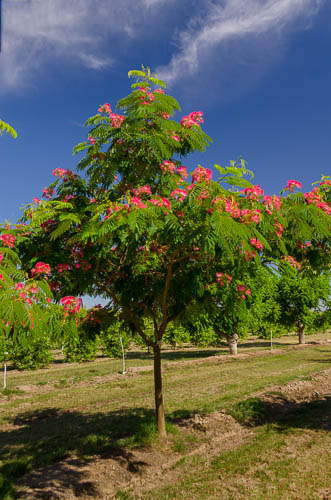
I find these trees really attractive
I am always attracted to the blooms and the silky soft looking foliage. I took a detour to enjoy the trees and was pleasantly surprised to see several Humming Birds flitting here and there all around the trees. As always, camera in hand, I tried to snap a few shots (wish I had my better, sharper lens with me).
For a while I had scared off the birds but a few Bumble Bees kept me company enjoying the same blooms.
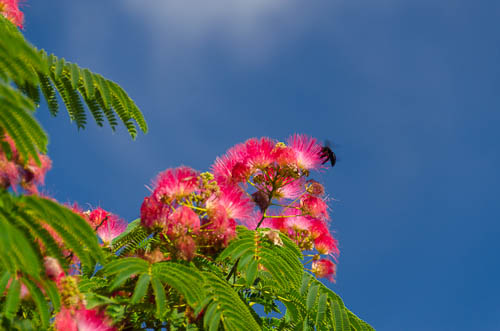
Bumble Bee on Fan Silk Albizia (Flame Mimosa)
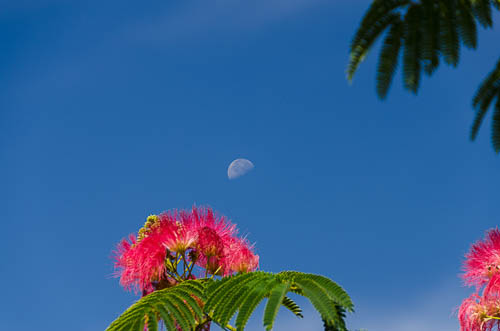
Couldn't pass up showing the moon still in the sky.
Before long the birds re-appeared but I had my original purpose to attend to - looking at a row of new trees to evaluate. More on those in the future. Overall - a nice distraction for the morning.
More photos can be seen here: Fan Silk Albizia
Ron Ludekens 6-7-13

